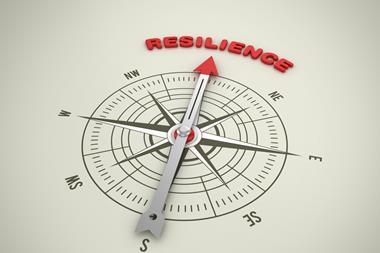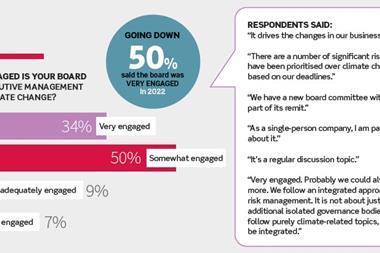EXPERT VIEW: Climate change may already be here, but we can – and must – work ahead of time to map out our exposures for the impacts still to come. International SOS’s James Wood explores how to build climate resilience, through data analysis, assigning accountability and securing investment.
In association with International SOS
Climate change resilience is no longer optional.
Every organisation will be impacted in some way by climate change, whether directly or indirectly.

This could be through negative effects on the health and security of employees, natural hazards endangering physical assets, issues through the supply chain, or even changes to the way a company operates.
Clearly, climate should be a foundational pillar of any company’s risk processes, but these threats are not easy to understand or measure.
It’s not just about looking at the weather – organisations must consider secondary and tertiary impacts and establish the appropriate steps to mitigate against a risk that is constantly changing.
Getting on the front foot
Building climate resilience starts with having the right expertise.
Make sure you have access to the right information and that you’re using it in the right way. That means analysis and intelligence to help understand the risks inherent in your operational environment.
For instance, if you’re expanding into new geographies, you need to map out what the local legislation covers and attitudes towards climate change, as well as how they’re set to evolve.
Only then can you understand what risks or opportunities might arise and feed them into your broader enterprise risk, business continuity and crisis management plans.
”We’re seeing the rise of chief resilience officers, but what does that role mean in terms of the day-to-day management of risk?”
Many organisations will need external help to successfully navigate this. For instance, there is a significant employee health element, but not all businesses have a chief medical officer.
Likewise, are internal security professionals trained to understand secondary and tertiary climate-related perils? If not, there may be blind spots.
Many firms struggle with climate mitigations because it’s not clear whose responsibility they are. We’re seeing the rise of chief resilience officers, but what does that role mean in terms of the day-to-day management of risk?
Assigning defined roles and responsibilities helps to make sure that nothing falls through the cracks.
Getting assessments right
The second area of focus when it comes to climate resilience is risk assessment. Too often, traditional risk analysis does not have enough of an in-depth focus on understanding and monitoring climate change.
Most risk analysis processes aren’t currently set up well enough to do the forward-leaning assessment that is so critical when it comes to climate change.
For instance, many organisations are sophisticated when it comes to tracking the paths of hurricanes and monitoring the impact of wildfires and flooding events. However, they don’t have the internal knowledge to map out the likely locations of events or how trends decades into the future will affect the likely impact of such events.
There is significant data available to be able to discern trends and evolutions, but it requires a dedicated analytical focus to help convert that into meaningful action
Breaking down siloes
Another critical requirement is breaking down silos between different departments.
There may be people who focus on the health and well-being of employees, and departments focused on the resilience of physical assets. There will likely also be someone focusing on the sustainability agenda, which is absolutely critical.
But if teams are doing those assessments and planning in isolation, then there are going to be blind spots in all areas. There needs to be collaboration, which is empowered and enabled from a top-down approach with senior board-level buy-in.
This allows organisations to map out the risk requirements and then start to put in place practical measures to manage them.
Investing in risk management
Too often, firms are only prepared to spend money in the wake of a crisis, when the damage is already done.
There’s a great rush to shore up supply chains, for instance by diverting stock or resources to manage a gap. The aim is business continuity, but in reality, this is achieved as much by what you do before an event, as the steps you take once it is upon you.#
”Firms are only prepared to spend money in the wake of a crisis, when the damage is already done.”
Climate resilience, in particular, requires upfront resource to achieve, whether that’s hiring in new expertise or external advisers, buying software or technology to better understand risk or investing in risk mitigation measures.
Securing this resource is not always straightforward, but highlighting the financial impact of extreme weather events can be a great way to focus the board’s minds.
So far in 2023, there have been $147bn in losses related to weather events. Investing in climate preparedness can help ensure a business weathers a storm.
An era of poly-crisis
Businesses have found themselves facing one disaster after another, getting through the pandemic only to be faced with the conflict in Ukraine, inflation and a proliferation of natural catastrophes.
Global businesses have experienced extreme wildfires, hurricanes and storms, this year alone. And there is very clear evidence that we are going to be faced with more frequent extreme weather events because of climate change.
It’s not just the number of events, but where they’re happening. The inherent risk environment is predicated on the ability of the authorities to manage, mitigate and respond to those events.
The variation in institutional ability to manage climate resilience across geographies, as well as the inherent risk environment, means the impact of climate-related events around the world will vary significantly.
”For chief risk, sustainability and resilience officers, the ability to map out that data can go a long way.”
All these considerations need to be compiled into an overlapping risk assessment.
Training exercises that simulate multiple crises concurrently can help focus the C-suite on the need to be prepared. Showing how the organisation would respond to a series of natural disasters can help codify what needs to be done.
Looking externally at how peers are investing in climate resilience can also be a good driver in adoption. When leaders see their peers planning for climate change, this can create impetus for internal progress.
For chief risk, sustainability and resilience officers, the ability to map out that data can go a long way.
Best practice
Your approach to climate resilience needs to consider a diverse range of factors.
You cannot simply focus on the events themselves but must also consider the health and well-being of your employees, your ability to forecast risk, how much buy-in you have at the C-level, and your access and expertise to drive analysis and assessment.
Clearly defined roles and responsibilities within your business are key.
There needs to be a clear mandate stipulated in a policy document, which outlines your organisation’s commitment to managing the impact of climate change.
”It starts with an acceptance by the organisation that they have a major exposure to climate change throughout the whole ecosystem of their operations.”
Appropriate investment is also critical. Firms must educate people within the organisation on the risks they may be exposed to and train managers on how they should approach this.
Fundamentally, it starts with an acceptance by the organisation that they have a major exposure to climate change throughout the whole ecosystem of their operations.
Only then can you build an effective strategy to manage the risks.
James Wood is security director at International SOS.
This expert view was taken from our Climate Change report, which can be read in the latest issue of the magazine.



















